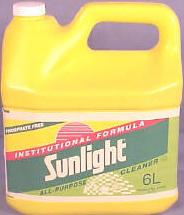|
The picture to the right of the title above is an exercise
in perception. Try saying aloud the name of the colour of each word in the
box (not the word that's written there, but the colour it's written
in).
Think about what's important to your
customer. Think about the product attributes that will
make a difference to that customer and how your customer
perceives your product in terms of these attributes,
especially as compared to your competitors. What
kind of a target market have you got? Are they
sophisticated enough that you would be thinking of using
an ad that depends on a high level of ability to perform
closure? Are you dealing with a group that has a definite
bias (can you sell Joe Clark T-shirts at an Liberal Party
rally?). Use the material in these chapters to help you
understand your customer better, and write about your
customer in the Assignment.
Sensory
Systems
and Ad Appeals to the Five Senses
Sensation - the body's response to these stimuli
Perception - how we
interpret that response
Hedonic Consumption -
acting as consumers in response to these stimuli |
Exposure
 |
Exercise
Fed Ex |
Many ads
use hidden messages, most of them harmless. Can
you find the hidden message in this company logo?
Try before looking at the
answer. |
|
Sensory Thresholds - Absolute and Differential
Two of the most complicated terms in this
chapter are under the heading, "Sensory Thresholds" -
Absolute Threshold and Differential Threshold. They are somewhat
easier to explain in terms of a specific product, which is why for
the entirety of this course you have a particular product to try
to fit into the structure given you.
| Absolute
Threshold - the minimum level of a stimulus,
below which there is no effect; the minimum amount below
which something either does not exist or is so faint as to
seem not to exist. Think of a lipstick. A girl can choose
a dark ruby red and outline full gorgeous movie-star lips.
Or she can choose a pale pale pink, nearly the colour of
her own skin, so pale that you are barely aware that she's
wearing lipstick. Here's where the term absolute
threshold comes in. If she's not wearing any lipstick
at all, she has pale lips. If she's wearing just a touch
of lipstick, you can tell she's got some colour, but it
looks just about natural. This lower limit of how little
lipstick, how pale a lipstick a girl can wear, is an
example of the absolute threshold. If she wore any less,
or a colour any paler, you would not be able to tell she
was wearing lipstick. (me, you can tell easily -- if I
come to class without lipstick you will assume the walking
dead have come to be with you).
Differential
Threshold - the difference between two stimuli
or between one level of a stimulus and another level of
that stimulus, where stimulus refers to something
that causes a change in an organism. In the example of the
lipstick, the stimulus is sight - the visible colour of
the lipstick. The absolute threshold was the amount of
colour less than which you would not know she was wearing
any. The differential threshold for the lipstick could be
the difference between the palest of pinks and the deepest
of reds. Or it could be the just noticeable
difference between palest pink and pale pink.
Differential threshold would also be involved in
determining the coverage of two different brands of
lipstick. Say you had one brand that gave you a full rich
pink colour and another that gave you just a pale thin
pink wash; that's a differential threshold between two
brands of lipstick. |
 |
You can use the absolute and differential
threshold concepts to analyze the product itself or the person who
uses it. What's the difference for a marketer between the girl who
uses a pale pink lipstick and the one who paints on a full
theatrical red lip? Let's take another example:
| Absolute
Threshold - another example, using the BMW, a
high performance car. Let's consider a guy who buys a BMW,
a guy who really loves his car for the sheer feel of power
as it moves out onto the highway (these aren't necessarily
sexist stereotypes by the way; I'm thinking of actual
people, and the person I know with a BMW happens to be a
guy). His absolute threshold involves the fact that he
won't buy a car that isn't known as a "performance
car," that doesn't at least have the reputation of
being a performance car.
Differential
Threshold Let's say he's considering two
different cars to buy. If you offer him a nice family
sedan with enough power to move along the highway carrying
four kids and a dog, he's not interested (note that these
things all intertwine, we've now got both performance and
style, but I digress...). If you offer him a vintage
sports car that used to have power but since it got the
crack in the engine block won't go up a hill at anything
faster than 40 km (my old MGB), he's not interested. Let's
say you even offer him another performance car, but not
the BMW. He's still not interested. Compared to the BMW,
these other cars have different levels of performance. He
wants a minimum level of performance, yes, and that's his
absolute threshold, but beyond that, he wants what the BMW
has to offer, not lower levels of performance. That's
differential thresholds.
Remember when you're
working on these assignments that you're not going to be
graded on whether you get the particular differential
threshold for a particular purchaser of your particular
product "right" -- I don't have these "right" answers!
You're being marked on how well you cover the material,
using your product as an example, and how correct your use
of Marketing theory and terminology is.
|
 |
Subliminal Perception -
I used to say not to spend much time on this
because it does not really exist. But in the Summer S1 Term, one of my
students. Monica Reis, found a website that made me see the concept
differently. When something is presented subliminally, you do not see
it. I used to think, if you can't see it then you can't show me an ad
where there is something I don't see. But using the FedEx ample from the
Waving Hand Question above, we can "see" a subliminal message in a
firm's logo. Here is the answer to the question posed about finding the
hidden message:
Answer to FedEx exercise

|
Look for the arrow between E and
x
(Sent in by Alex Katz, CB3210 Summer 2001) |
If you're like most people, BEFORE you see the answer, you have
not seen the little white forward arrow between the E and the x at
the end of the logo. Given that we cannot "see" that until the
secret is pointed out (most of us anyway), I'm willing to say that
yes, there is such a thing as a subliminal message.
Do see if you can find anything related to subliminal messages
in your ad or a proposed ad for your project product.
Attention
Personal Selection Factors
  |
It's
important to recognize in this
discussion of perceptual filters
that we are studying
Consumer Behaviour with reference to North
American culture; things may be very different
elsewhere. They are often very
different between Canada and our
closest neighbour the United
States; they are frequently very
different between English- and
French-speaking Canada. |
 |
Perceptual
Selectivity
- we
notice only a small amount of what's
out there, utilizing
Perceptual
Filters
Perceptual
Vigilance - we tend to notice things
immediately important to us
Perceptual
Defence - we don't see what we
don't want to see
|
Adaptation
Whether
we notice things differently or
even continue to notice them at all over
time depends
on how it registers
with us in terms of
intensity
duration
discrimination
exposure
relevance |
|
 |
Stimulus
Selection Factors
|

|
How
much we notice and react to
something also depends on the
thing itself; its
size
colour
position
novelty |
|
Think about these factors and what it
tells you about your target market when you consider how
they will react to each of these. What kind of a person
only notices an ad if it is totally and immediately
relevant to him at that moment? What kind of person,
alternatively, keeps a running file in her head of
seventeen different ads for sixteen different brands of
the same product before coming to a decision to buy
one?
Interpretation
Schema
Sunlight recently sent out samples to customers. They used
the concept of Priming, whereby
certain images tend to make the consumer more receptive to the
advertisement. They hoped that consumers would use the first schema, but
many of them used the second one:
Schema 1:
Yellow = fresh colour
Lemon = fresh scent
Therefore: Use this product for cleaning
But some consumers used this SCHEMA instead:
Schema 2: Yellow = fresh colour
Lemon = fresh fruity juice
Therefore: ?? What do you think happened? |
 |
Stimulus
Organization
Gestalt Psychology

Closure
asks us to mentally complete a
picture |
|
One of
these things is not like the others,
One of these things just doesn't belong,
Can you tell which thing is not like the
others
By the time I finish my song?

Similarity
is a technique we use from our earliest
days to help us remember something by how it's like something
else we already know |

Figure/Ground
implies a situation where the subject
stands out easily against the background;
this can be visual, or as understood by
any of the other senses
|
 |
Exercise
Gestalt |
Which
of these 3 kinds of advertising might work best
with people who buy your product? What does that tell you about your target market?
|
|
|
Bias - The Eye of the Beholder
- the potential for bias in interpretation is
huge; at the
base of all advertising strategies is the
question, "How will the potential buyer
interpret it?"
|
 |
Symbols and
Semiotics

Cardiopulmonary Institute at King's
Daughters Medical Clinic |
| OBJECT
(what's being sold?) |
| SIGN
(how is it depicted?) |
| INTERPRETANT
(meaning) |
Perceptual Positioning
|
|
Possible
Dimensions
Price
Leadership
Attributes
Product Class
Occasion
Users
Quality |
|
The example given of Price Leadership in the textbook
is slightly different from how we usually think of Price
Leadership. Price leadership essentially means being a
strong enough player to be able to set prices where you
want to set them. This usually refers to setting low
prices - leading the pack in providing low prices to
consumers (WalMart is an excellent example of price
leadership in setting low prices for the competition to
have to follow). It also can refer to being known enough
as a quality product that you can set a high price and
know that people will pay it. Bayer Aspirin does this; it
costs more than other acetylsalicylic acid. In the example
in Solomon's textbook, he cites L'Oreal, a company which
practices price leadership at both ends of the scale -
their Noisome face cream is priced high, and their
Plenitude brand is priced low, and because L'Oreal is a
strong solid contender in the skin-care field, they can
determine what prices they will set for each of those
products.
For your product, just consider whether one or the
other end of the Price Leadership scale is accurate for
your product. Remember too that you don't have to come up
with an example for each of these six attributes; very few
products position themselves on all six. Many use just one
or two dimensions.
One Minute Paper
Time for Group Meetings
|